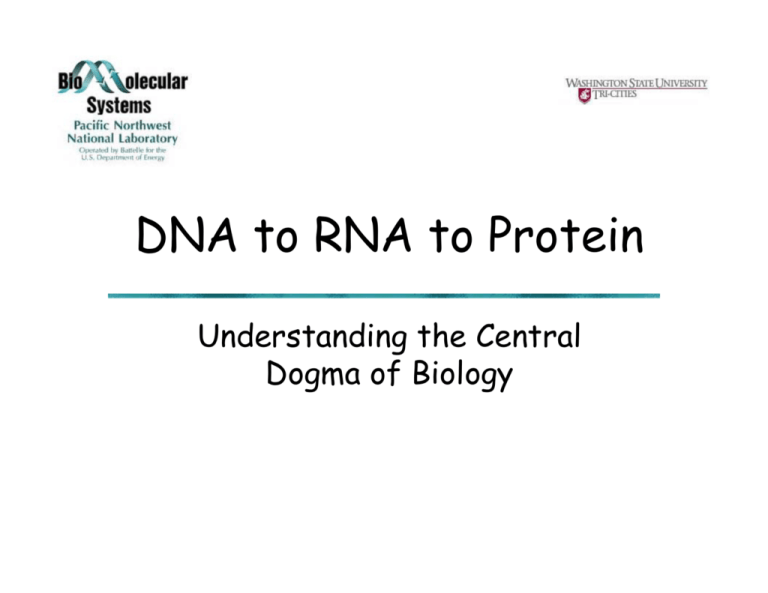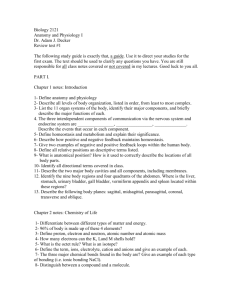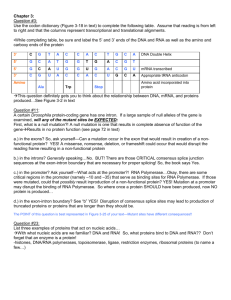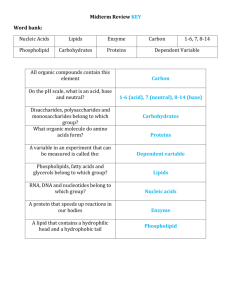Structure I: DNA to RNA to Protein
advertisement

DNA to RNA to Protein Understanding the Central Dogma of Biology Structure of Cells The Cell as a Factory Energy production Project management Data retrieval Data storage Data management Data processing Shipping Waste management Routing Facilities Transportation Communications Manufacturing Packaging Machine shop What are Cells Made of? • • • • • Membranes (fats) Proteins Carbohydrates (sugars) Cofactors (vitamins) Nucleic acids How is a Cell Assembled? • There must be “information” that specifies the assembly of cell parts • DNA contains the information necessary to build a cell • The mechanisms by which DNA gives rise to cells and organisms is at the heart of the “central dogma” of biology Central Dogma of Biology DNA Data storage RNA Readout PROTEIN Execution What is DNA? • DNA is deoxyribonucleic acid • It is a polymer of nucleotides • It encodes the information necessary to build a cell • It allows the storage and replication and execution of cellular information Structure of Nucleotides A C G U T Nucleotides Polymerize to Form Nucleic Acids Base-pairing Controls Formation of Second Polymer Chain Base-complementation Allows DNA Replication Base-pairing precedes polymerization DNA polymerase makes DNA The Two Strands of DNA are Complementary Central Dogma of Biology DNA Data storage RNA Readout PROTEIN Execution What are Proteins? • Proteins are polymers of amino acids • Each protein has a unique sequence of amino acids • The sequence of amino acids specifies protein shape and function Proteins Have Many Functions in Cells • They make most of the structures in cells • They are the enzymes that break down food • They are responsible for building new parts • They act as the eyes and ears of cells Most cell functions are carried out by proteins Proteins Make Cellular Structures To folded protein LLCDGGALPTYSLQTIAALMRRTLGGDEHICVLISTH From primary transcript To assembled structure Cells are built from proteins (and some other stuff) What are Amino Acids? Amino Acids Polymerize to Form Proteins H 0 H 0 -N-C-C-N-C-C-NHR HR H Sequence of Protein Dictates its Folding Pattern How Does DNA Specify the Sequence of a Protein? • A DNA sequence must be “decoded” to make a protein • This decoding requires creation of an RNA template • Creation of “messenger RNA” is called transcription • Creation of protein from the mRNA is called translation Central Dogma of Biology DNA Data storage RNA Readout PROTEIN Execution Two Types of RNA DNA ATGGCCTAAGCTCTGA mRNA UACCGGAUUCGAGACU mRNA looks like DNA and is essentially a copy of a gene “transfer” RNA (tRNA) is an adaptor used in protein synthesis Information Flow in Protein Synthesis Where Do Genes Start and Stop? START SIGNAL start site STOP SIGNAL Synthesis of RNA Understanding the Genetic “Code” ANY STRAND OF RNA ……CUCAGCGUUACCAU… CAN BE READ IN THREE DIFFERENT “FRAMES” Genetic Code is Translated by Two Sequential “Adaptors” Net result: tryptophan is selected by its codon Proteins are Made on Ribosomes Information Flow is Simpler in Procaryotics The Structure of Genes in Eucaryotes Can Be Complex Relationship Between Genes and Proteins So What is Next? • How does the amino acid sequence of a protein specify its function? • How about those other parts of cells (such as membranes)? How are they made? • How are cellular processes regulated? • How do we study cells and biochemical processes?






